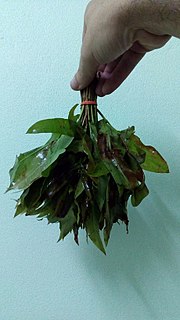Related Research Articles

Cratoxylum formosum is a species of flowering plant in the Hypericaceae family. Its commercial name in timber production is "mampat".

Platylobium formosum, also known as handsome flat-pea, is a shrub that is endemic to Australia. It is a member of the family Fabaceae and of the genus Platylobium.

Dendrobium formosum is a species of orchid.

Adiantum formosum, known as the giant maidenhair or black stem maidenhair is a fern found in Australia and New Zealand. It was one of the many species authored by Scottish botanist Robert Brown, appearing in his 1810 work Prodromus Florae Novae Hollandiae et Insulae Van Diemen. Its species name is the Latin adjective formosus "handsome" or "beautiful".
Anthidium formosum is a species of bee in the family Megachilidae, the leaf-cutter, carder, or mason bees.
Rosenbergiodendron is a genus of plants in the Rubiaceae. At present, it contains 4 recognized species, all native to tropical America.

Dorcadion arietinum is a species of beetle in the family Cerambycidae. It was described by Jakovlev in 1897.
Dorcadion divisum is a species of beetle in the family Cerambycidae. It was described by Ernst Friedrich Germar in 1839. It is known from Greece and Turkey.

Dorcadion cinerarium is a species of beetle in the family Cerambycidae. It was described by Johan Christian Fabricius in 1787, originally under the genus Lamia. It is known from Ukraine, Azerbaijan, and Russia.

Dorcadion scabricolle is a species of beetle in the family Cerambycidae. It was described by Dalman in 1817. It is known from Azerbaijan, Iran, Armenia, and Turkey.
Dorcadion glycyrrhizae is a species of beetle in the family Cerambycidae. It was described by Pallas in 1773.
Dorcadion almarzense is a species of beetle in the family Cerambycidae. It was described by Escalera in 1902. It is known from Spain.

Dorcadion fuliginator is a species of beetle in the family Cerambycidae. It was described by Carl Linnaeus in his landmark 1758 10th edition of Systema Naturae. It is known from Spain, Belgium, Luxembourg, Netherlands, Portugal, France, Germany, Austria, Lithuania, and Switzerland.
Dorcadion marmottani is a species of beetle in the family Cerambycidae. It was described by Escalera in 1900. It is known from Spain.
Dorcadion mosqueruelense is a species of beetle in the family Cerambycidae. It was described by Escalera in 1902. It is known from Spain.
Dorcadion mucidum is a species of beetle in the family Cerambycidae. It was described by Dalman in 1817, originally under the genus Lamia. It is known from Spain.
Dorcadion terolense is a species of beetle in the family Cerambycidae. It was described by Escalera in 1902. It is known from Spain.
Genoplesium formosum, commonly known as the Cathcart midge orchid is a small terrestrial orchid found in southern New South Wales. It has a single thin leaf and up to twenty five dark reddish purple flowers with darker lines.

Leucospermum formosum is a large upright shrub of up to 3 m (10 ft) high, from the family Proteaceae. It grows from a single trunk and its branches are greyish felty. The softly felty leaves are lance-shaped to elliptic, 6½–10 cm long and 14–20 mm (0.56–0.80 in) wide. The flower heads are flattened and about 15 cm (6 in) across, and consist of bright yellow flowers from which long, styles emerge which are strongly clockwise bent just below the white, later pink thickened tip. From above, the heads look like turning wheels. It is called silver-leaf wheel-pincushion in English. It flowers during September and October. It is an endemic species of the Western Cape province of South Africa.
References
- ↑ BioLib.cz - Dorcadion formosum. Retrieved on 8 September 2014.